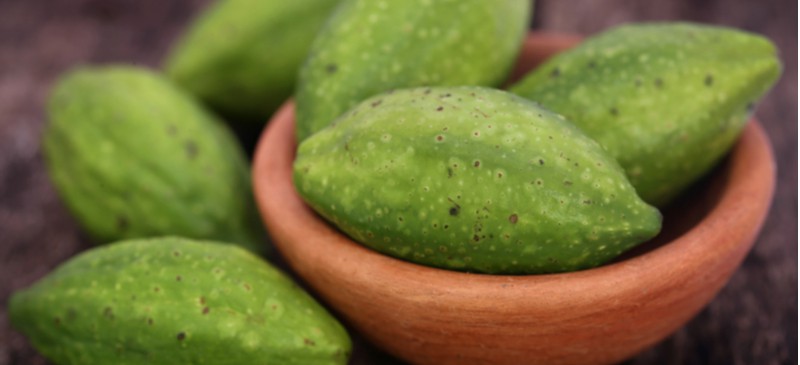
Haritaki is a fruit used in Ayurvedic medicine for a wide range of traditional remedies, such as treating pain, anxiety, certain infections and indigestion.
It’s one of three main ingredients found in triphala and is considered in Ayurveda to be a naturally rejuvenating herb, especially well-suited for people with inflammation and trouble relaxing. It’s even been referred to as the “King of Medicines” due to its many therapeutic benefits.
What Is Haritaki?
Haritaki (Chebulic myrobalan), also called Indian walnut or Indian hog plum, is a fruit that’s cultivated from the seeds of Terminalia chebula trees. The rind of the fruit is most often made into haritaki powder that has a number of medicinal uses, considering it acts as a natural laxative, has astringent properties and contains antioxidants.
Haritaki trees belong to the Combretaceae plant family and grow in tropical and subtropical regions, mostly throughout India, Nepal, China, Sri Lanka, Malaysia and Vietnam.
The fruit itself is drupe-shaped, has a hard green exterior and has ridges along its surface. Inside the flesh ranges from a yellow to orangish-brown color.
In addition to the fruit being valuable, different parts of the tree are also used for therapeutic purposes, including the roots, stems, barks, branches and leaves.
There are several different types of haritaki products made from Terminalia chebula trees, each with its own unique nutritional profile and applications. These types include:
- Vijaya
- Chetaki
- Rohini
- Putna
- Jayanti
- Abhaya
- Amrita
Benefits/Uses
What is haritaki good for? In Ayurvedic medicine, this fruit is believed to be “tridoshic in nature,” meaning it helps balance all three doshas.
Because it may act like an adaptogen, it’s especially prized for helping to balance the Vata dosha, meaning it has stress-fighting effects. It’s considered a good supplement for those with insomnia or restlessness, and it may increase resiliency and sense of well-being due to its calming, sedative properties.
Traditionally, it’s been used in various ways to help treat conditions including:
- fever
- cough and cold symptoms
- ingestion of harmful substances
- diarrhea
- poor vision
- indigestion and heartburn
- loss of appetite
- skin disease
- gingivitis
- asthma
- low libido
- infertility
- memory loss
Here’s more about some potential haritaki benefits:
1. Has Antioxidant and Anti-inflammatory Effects
While the fruit itself is high in certain antioxidants, such as vitamin C and vitamin E, it’s also thought to help increase concentrations of several antioxidants in the body — including glutathione and superoxide dismutase, which fight oxidative stress.
Due to its anti-inflammatory properties, it may have neuroprotective effects that can help prevent loss of memory and improve mental performance.
Because it has the ability to dull inflammation, hatitaki may also be able to help people with pain, such as those with arthritis. One randomized, placebo-controlled, double-blind study found that haritaki supplementation helped relieve pain, improve physical function and improve quality of life among adults with joint discomfort/osteoarthritis in their knees.
2. Holds Natural Antibacterial and Antiviral Properties
Because it can fight proliferation of certain types of harmful microbes, haritaki is used in oral and dental care to prevent cavities and gum disease. It can be added to distilled water or mouthwash in order to prevent growth of bacteria that are linked to the development of dental cavities.
Similarly, it’s added to some eye rinses to prevent stye infections and conjunctivitis.
Another use of certain types of haritaki is in wound healing, since it may prevent infections from forming in cuts, burns, etc. It’s been found to have antibacterial, antiviral and antifungal properties that can assist in treatment of fungal infections, ulcers and more.
Haritaki powder can be applied topically to the skin to potentially reduce wrinkles, hyperpigmentation, acne, etc.
According to a 2020 study, green tea, black tea and haritaki plant extracts may be potential therapeutic candidates for helping to treat infections.
3. Can Help Treat Digestive Issues, Including Constipation
Haritaki has long been used for purgation, detoxification and for improving overall gut function and digestion. It may be able to play a role in treating gastrointestinal issues such as heartburn, diarrhea, flatulence, peptic ulcers, cramps and constipation, including by shortening transit time of stools and promoting elimination due to its mild laxative effects.
It’s thought to improve digestion by enhancing the secretion of digestive juices and by reducing inflammation in the gastrointestinal tract. It may also help “feed” healthy probiotic microbes in the gut that support nutrient absorption and immunity.
Is haritaki good for the liver? While not many studies have looked at this specifically, it may facilitate the liver in eliminating toxins from the body and also assist in maintaining normal cholesterol levels.
READ RELATED: Dangers of Energy Drinks + Healthy Alternatives to Boost Alertness
4. Helps Ease Sore Throats, Coughs and Allergies
Many respiratory issues may be treated in part with help from haritaki due to its anti-inflammatory, antibiotic and anti-asthmatic properties. It seems to help decrease accumulation of phlegm and improve breathing by supporting overall health of the lungs and airways.
It can also help improve immune defenses and fight microbes that may lead to respiratory infections.
5. May Support Metabolic Health
Certain animal based studies have suggested that compounds within haritaki can potentially help treat high blood sugar, insulin resistance, high cholesterol and other factors related to metabolic syndrome. The carbs and sugar present within this fruit are believed to be slowly digested and to positively impact blood sugar levels.
Risks and Side Effects
Is haritaki safe? Because it has a long history of use in traditional systems of medicine, it’s believed to be generally safe — however, there isn’t necessarily enough research to show this is always the case.
Overall, more research in humans is warranted to support that haritaki has the beneficial effects described above. Most of the existing evidence has come from animal-based and laboratory studies, so it’s difficult to say for sure how well it can help treat various ailments.
Certain people should avoid using this supplement due to potential interactions, including those who take blood-sugar-lowering drugs, pregnant or nursing women, and children. If you take medications to control any chronic condition, speak to your doctor before adding any new herbal treatment to your routine.
Always start with a low dose, and gradually increase if you have a good reaction. Stop using this product if you experience side effects, such as diarrhea, stomatitis, dehydration, fever or fatigue.
Nutrition
Haritaki is high in vitamin C, antioxidants and a number of bioactive compounds. Within this fruit you’ll find compounds including:
- chebulin
- chebulagic
- corilagin
- pyrogallol
- ferulic acid
- vanillic acid
- phloroglucinol acid
- caeffic acid
Unlike most fruits, it even contains beneficial fatty acids, such as linoleic acid, oleic acid and palmitic acid (the same types found in coconuts and olives).
Antioxidants present in Terminalia chebula species include phenolic compounds, flavonoids, quinines and tannins, which are thought to contribute to a healthy aging process by fighting free radical damage. Additionally, it provides essential minerals, such as magnesium, potassium, iron and copper.
Dosage
While you’ll most often find this fruit in the form of dried haritaki powder, it’s also possible to take it in capsule form. Depending on where you are in the world, you may also be able to find the fruit itself or dried haritaki fruit.
What does haritaki taste like? The fruit itself is described as having a sweet, sour and somewhat bitter/astringent taste. Many people find hariktai powder to be bitter, so for these people taking capsules may be a better option.
How much should you take?
This depends on the specific type of product you take — for example, the particular species and whether or not it’s mixed with other herbs.
A general recommendation for adults is to take about five to 10 grams of powder once or twice a day. (Children should take up to two grams per day.) This is a small amount and may equate to about 1/2 teaspoon, once or twice daily.
Always read directions carefully since some products may need to be taken in smaller doses.
When should you take haritaki powder?
It can be taken either with or without food. The powder is often mixed with warm water or milk, sometimes combined with a teaspoon of honey or other herbs to improve the taste.
It can also be added to smoothies or other recipes.
How do you apply it to your skin?
Not only can you take it by mouth, but haritaki powder can be applied topically to the skin in the form of masks and spot treatments. To make a homemade facial treatment, mix one tablespoon of haritaki powder with two tablespoons of rose water, and put it on your face. Then let it sit for about 20 minutes before washing it off.
You can also make a hair treatment using the powder by adding it to water to form a paste, then applying it to your hair for about one hour before rinsing.
Conclusion
- Haritaki, a fruit that grows on the tropical Terminalia chebula tree that’s native to Asia and India, provides antioxidants, vitamin C, beneficial fatty acids and other protective compounds.
- This fruit has been used in Ayurvedic medicine for centuries and is included in the popular remedy triphala. It’s thought to have balancing effects for all dosas but may be best for Vata doshas since it tends to be calming and rejuvenating.
- Potential haritaki benefits include helping to treat infections, skin and eye problems, indigestion, cavities, insulin resistance, high cholesterol, respiratory issues, and more.
- It can be taken in powder or capsule form and also applied to the skin and hair. Read directions since products vary in terms of dosage recommendations.
Source: Dr. Axe | Nutrition






